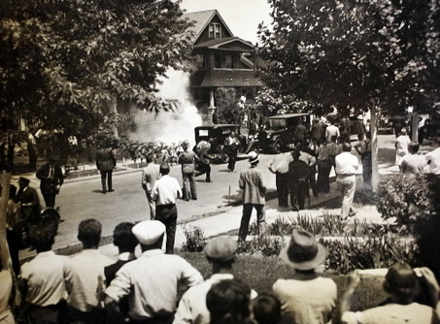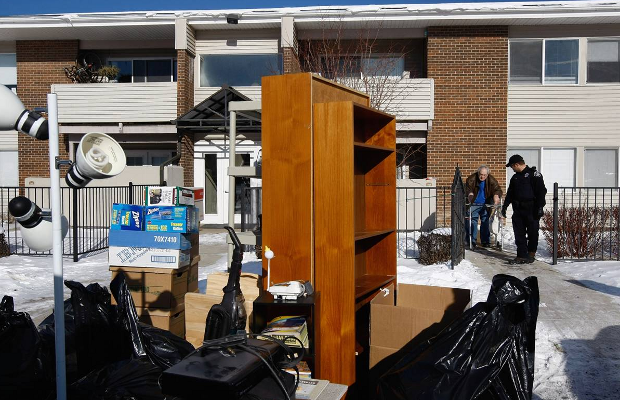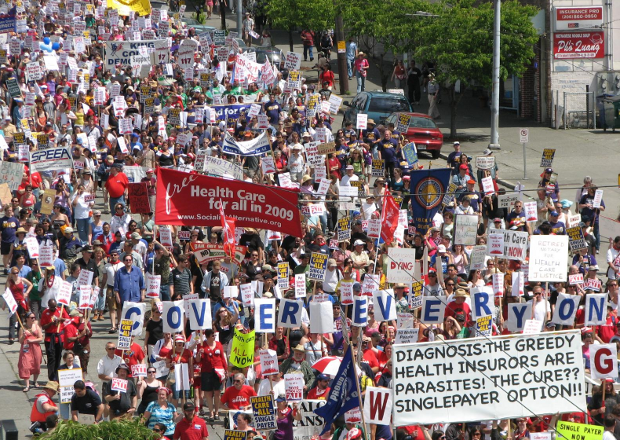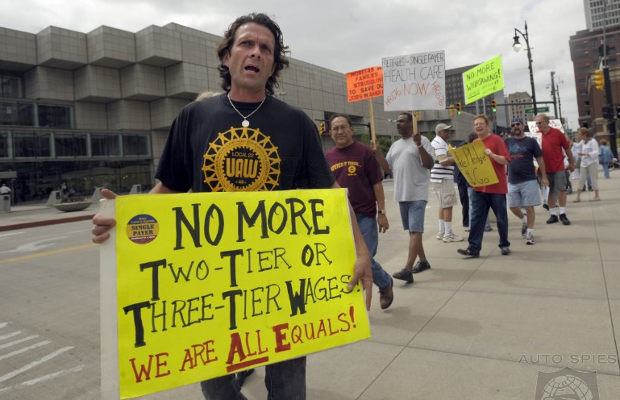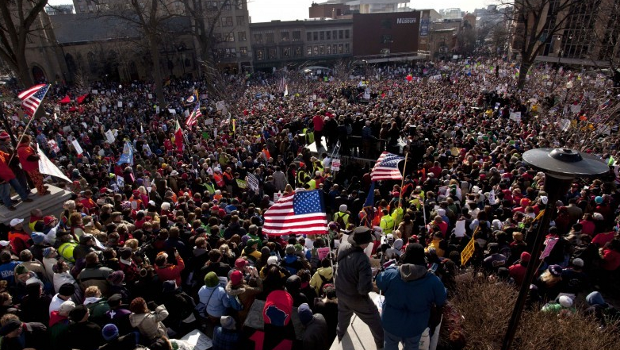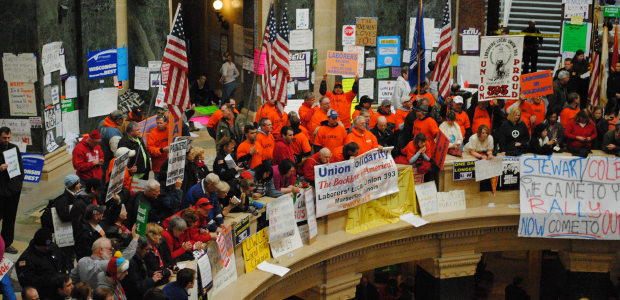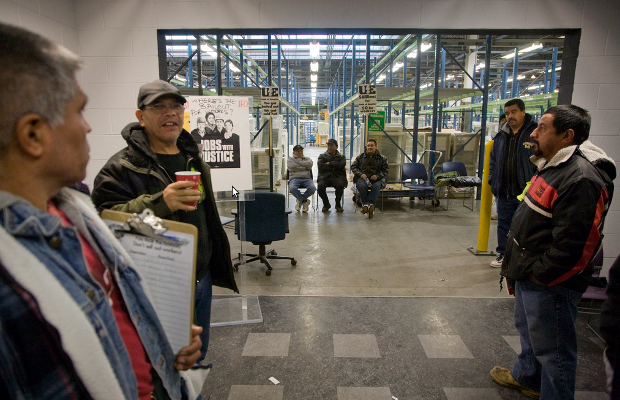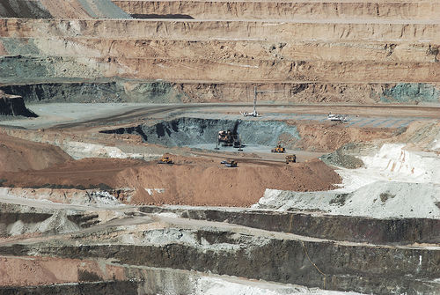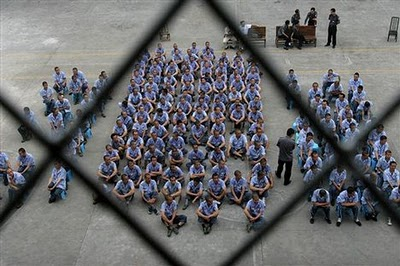Since July of 2011, the mainstream media have been increasingly talking about a “double dip” “recession” in the United States But we can safely assert that for most working people, the “recession” has never ended, and is about to get worse.
Background
To understand the class struggle in the United States since the financial meltdown of 2007–2008, we must briefly consider the history of the previous four decades, since the end of the wildcat insurgency of the late 1960s/early 1970s. The history of the American working class since ca. 1973 (as is well known), has been an almost uninterrupted wave of defeats and rollback. This has been described as a “class war in which only one side was fighting.” Real wages have fallen in those decades by a conservative estimate of 15 percent, and starting as early as 1960, the one-paycheck blue-collar family began to disappear. Today, in a typical working-class family, two to three paychecks are necessary, and at least one is required to cover housing costs (typically 50 percent of household income) alone. The average work week has increased at least 10 percent for those holding full-time jobs; in reality, the work force increasingly resembles the “hourglass society” with “professional strata” working 70-hour weeks, and a majority of the population casualized into irregular part-time work. The top 10 percent of the population has claimed roughly 70 percent of all increases in income over the same period. Large parts of the old industrial Northeast, it is once again well known, have been turned into the “rust bowl,” with low-paying, dead end “service” jobs (e.g. Wal-mart) replacing the old, moderately paid and relatively secure blue-collar jobs. The United States competes with South Korea for having the most dangerous workplaces in the “advanced” capitalist world, with 14 workers killed on the job every day. 2 percent of the population (seven million people),[1] largely black and Latino, are awaiting trial, in prison or on parole, in large part the result of the “war on drugs.” With hundreds of thousands of people losing homes and apartments after losing their jobs, homelessness has soared, intensifying the “war on the poor” in police harassment, herding people into fetid shelters that are little more than prisons, and the criminalization of street people.
This, then, is a snapshot of social reality in the “richest country in the world.”
Decline of Strike Activity
In the face of this capitalist offensive since the 1970s, the classical strike, not to mention the wildcat strike, declined to near-invisibility. 20 percent of American workers were involved in strikes or lockouts each year in the 1970s, and only 0.05 percent in 2009. The old industrial unions were seriously weakened by de-industrialization and capital-intensive innovation requiring fewer workers; they fell from 35 percent of the work force in 1955 to 12 percent today, and the majority of those remaining are in public sector unions.[2] (In order not to be misunderstood: most of the major unions, up to 1973, were fighting the rank-and-file wildcat insurgency, not the capitalists. Nevertheless, their loss of membership reflects in part their inability to even continue the “business unionism” they practiced into the 1970s.) Those workers who retain regular jobs with decent wages and benefits, when they do strike, have almost without exception remained within the bounds of legality and narrowly-defined “bargaining units” that guarantee defeat before the struggle begins.
Pyramiding of Consumer Debt
The American working class and “middle class” (an ideologically-loaded term tied up with the nearly-extinct “American dream” of a steady job, home ownership and a decent retirement) partially compensated for the declining real wages after the 1970s with ever-deepening consumer debt. Beginning in the 1990s, this was complemented by the housing bubble, propagated by the media-touted myth that “housing prices never go down,” and fed in the 2000s by the “sub-prime” bubble, when virtually anyone could get a mortgage and buy a home, or get a second mortgage, and use these imaginary “assets” as a basis for further credit. A large part of the “recovery” from the 2000–2003 meltdown of the dot.com bubble was related to housing construction and the industries feeding into it, such as appliances and furniture. This piling up of consumer debt by working people, blue or white collar, paralleled the unprecedented increase of state (Federal, state and municipal) debt, and the external debt of the United States (total net dollars held abroad, minus U.S. assets abroad) of at least $10 trillion.
Thus the actual eruption of the crisis with the 2007 bursting of the real estate bubble, followed by the spasms set off in 2008 in the banking sector, was merely the culmination of a long process of buying time with debt pyramiding since the 1970s, reflecting an underlying crisis of profit (and ultimately of value in Marx’s sense) in the “real” economy. But that is, for the purposes of this article, another story.
The Political Dynamic
One must not overlook the weight of the November 2008 election of Barack Obama (elected in all probability by the outbreak of the crisis in October, weeks before) in the overall social climate. As in 1929–1934, the great majority of the US population has initially reacted to the crash with stunned silence. Obama, denounced by the “right” (the Republican Party, and in the past two years the radical right Tea Party faction of the Republicans) as a “socialist” (not to mention a “Muslim,” and even a “Marxist”), in fact has carried out policies to the right of his predecessor George W. Bush in almost every area. But the response to them has been muted because his liberal base has given his government every benefit of the doubt. Obama has intensified the “war on terror,” which increasingly is extended to domestic opposition[3]; he has deepened the US involvement in its losing wars in the Middle East (Iraq, Afghanistan) and drone bombings in Pakistan. His “economic team” included well-known hatchet men such as Lawrence Summers (who as Undersecretary of the Treasury had supervised the pummeling of South Korea in the 1997–98 Asia crisis), Paul Volcker (who as head of the Federal Reserve Bank had administered the deep recession of 1979–1982) and Tim Geithner (former head of the New York Federal Reserve Bank). This team has engineered huge bail-outs of the collapsing banks and real estate institutions, guaranteeing trillions of dollars of bad loans at 100 percent, while doing little or nothing for the blue and white-collar workforce, not to mention the ever-growing marginal and homeless population. Obama’s Orwellian health care “reform” (also denounced as “socialist”) was virtually written by the big private health insurance companies, which dominate the retrograde U.S. health care system. In December 2010 Obama extended unemployment benefits in a “deal” with Congress that also extended Bush’s tax cuts for the rich, which had cost the Federal government $200 billion a year in lost revenue every year since 2001, while the wars in Iraq and Afghanistan have cost $1.5 trillion, if not more. His administration has overseen more deportations of illegal immigrants than in all the Bush years, falling most heavily on the marginal Latin Americans who came into the country during the pre-2007 housing boom to work in construction, and who lost those jobs when the boom collapsed. In the June–July Washington charade over the US Federal deficit, the radical right (Tea Party) minority, with huge leverage over the lower house of Congress, gave Obama cover to shift even further to the right, preparing for big cuts in “entitlements”—another ideologically-loaded term referring to medical care for the poor and elderly and for the Social Security system for retired people. These cuts will emerge from the “bipartisan” super-committee, composed of six Democrats and six Republicans, due to enumerate in November the cuts that no one wanted to specify in the resolution of the summer standoff. All these developments illustrate the historical role of the Democratic Party, namely to enact policies which would arouse serious opposition if carried out by Republicans.
Good cop – bad cop
The American political system has been described as consisting of a right-wing party and a far right-wing party; since at least the 1880s, the two dominant parties have been engaged in a “good cop/bad cop” routine. The poorer 50 percent of the population does not vote, and official politics has receded into a shadow play that feeds a general passivity and cynicism. This is one of the contexts that explain strange phenomena such as the current Tea Party; when people do mobilize, right-wing and (less in evidence today) left-wing populisms (the revolt of the “little guy”) are the first safety valves of the system.
The Tea Party emerged as a force on the right wing of the Republican Party starting in 2009, expressing better than other organized political groupings the right-wing populist rage which has been part of the American political landscape, off and on, since the late 1970s. It represents a “declining demographic” of older, white, “middle” and “upper middle” class people who imagine that America’s problems can be solved by a strict balanced budget at every level of government and therefore a “minimal state” overseeing an unfettered “free market.” Such an economy never existed, even in the pre-1914 era when the state was a much smaller part of “GDP” but still played a central role in tariff policy, Indian removal for the expansion of the southern slave economy, and land seizures for railroads and canals. The real content of this Tea Party mirage would of course be a great strengthening of state repression, and the military maintenance of the (declining) U.S. empire, while gutting all remaining “social” dimensions of the state that the US radical right associates with the “socialist” New Deal of the 1930s and Lyndon Johnson’s “Great Society” of the 1960s. Its overwhelmingly white social base points to a (largely) unspoken but very real racial agenda of people frightened by demographic trends pointing to a white minority in the population by 2050, and by a black president. The Tea Party’s real function in U.S. politics is to allow the “center” (Obama et al.) to move farther to the right, permitting the “center” to appear as a rational, sane alternative to the “market fundamentalists.”
It is important to note that a near-universal belief that the crisis was “caused” by some elite, whether bankers or government regulators, drowns out any serious analysis of the underlying “crisis of value,” of which banks, consumer credit, real estate bubbles or government regulation are mere epiphenomena.
In November 2010, right-wing populist rage at Obama’s “socialist” measures (the bailout of the banks, health care “reform,” watered-down and mainly symbolic attempts at government regulation of finance) led to massive Republican gains in both houses of the US Congress, wiping out a Democratic majority in the (lower) House of Representatives and almost capturing the Senate. Much of Obama’s 2008 base, disappointed (or disgusted) with his virtually open rule in the interests of big capital, simply stayed home. (One should not overlook the right-wing populist rage, rarely articulated openly, at Obama’s black skin.)
The “Recession” and Muted Resistance
Since fall 2008, the official unemployment rate in the United States has reached 9.1 percent, and is in all likelihood closer to 15 percent, with figures endlessly “revised,” including anyone who works one hour a month as “employed” and not including millions of people who have given up looking for work altogether. Hundreds of thousands of people have lost their homes after losing their jobs, especially in the previous “boom” areas such as California’s Central Valley, Las Vegas, or Florida; millions more are holding mortgages that are “under water” (higher than the actual value of their homes). There are years of backlog of empty houses and real estate prices continue to fall. At this writing—late September 2011—world stock markets have been gyrating wildly, which may outdate these figures within days.
One striking phenomenon connected to the housing collapse is the near-absence of collective resistance to foreclosures and evictions. This is an important contrast to the early 1930s, when in New York City (for example) thousands of people gathered to protect neighbors threatened with evictions,[4] or in rural areas where farmers (often armed) attempted to protect farm land from seizure by banks. One comrade in one of the most economically-devastated cities (Baltimore, Maryland), which has rivaled Detroit in decline since the 1970s, reports that the great majority of evicted or foreclosed people there are simply “ashamed” of their situation, conceal it from neighbors, and leave quietly in the night.
Attacks on Health Care and Pensions
Since 2007–2008, overt class struggle has shifted to an important extent from the work place to the confrontation with the bankrupt state, at every level (Federal, state and municipal). But this shift was prepared by the earlier defeat of workers in virtually every blue-collar industrial sector, headed by the auto workers. Public sector workers and their services, after decades of propaganda about the superiority of privatization, can be demonized as privileged, overpaid parasites because they are the last workers still benefiting from relatively secure jobs and benefits. Since blacks are disproportionately represented among public sector workers, this demonization in some quarters also flows from a muted racial agenda.
A near-omnipresent dimension of this confrontation is over health care costs, given America’s retrograde private health care “system.”
The United States is the only “advanced” capitalist country having no universal health care. In 2009, 50 million people had no health insurance. Health care costs amount to 15 percent of “GDP,” and are projected to rise to 20 percent by 2020. Canada, with a universal health system, spends 10 percent. It is estimated that the elimination of private health insurers (HMOs, or Health Management Organizations) and their “administrative costs” would eliminate 20–30 percent of health care costs. Further costs are added by the close relationship between the major pharmaceutical companies (“Big Pharma”) and the political class. (Federal law, for example, forbids states to buy cheaper generic drugs from Canada.) A majority of Americans favor a “single payer” (universal) health system, but the mainstream political parties and the media have imposed a virtual blackout on discussion of that alternative.
Even before the full eruption of the crisis, many of the strikes that did occur were focused on health care.[5] (For many people, particularly those with families, the private job-related health plan is as important, sometimes more important, than the wage itself.) As the crisis greatly reduced tax income of states and cities, they were increasingly unable to pay health care and pensions for retired public employees. At every level, politicians, demagogues and think tanks bemoan “spiraling health care costs” but silence any serious discussion of their true sources in the control of health care by private insurance companies and the bloated prices charged by the big pharmaceutical companies.
Starting in 2014, anyone of the 50 million people currently without health insurance will be liable to a considerable fine if they do not sign up with a private health insurer; current rates for an individual are on the order of $500 per month; for a family more than $1000 per month. (While this article was being written, a Federal court ruled this aspect of “health care reform” unconstitutional, but the Obama government will appeal the decision in a higher court.)
The health care crisis goes together with the crisis of pensions in both the private and public sector. Starting in the 1990s, more and more employers shifted from paying for full “defined benefit” pensions to paying into “40lks” where employer and employee both pay into a fund that is then invested…in the stock market, naturally with fees for the stock brokerage. Studies have shown that 40lks leave retirees with only 10 to 33 percent of what the older defined benefit pensions paid (and which only covered one-third of the work force at their peak). This trend, combined with the coming Congressional attacks on Medicare and Social Security, points to accelerating impoverishment of the elderly. The crisis depletes the budgets of state and local governments, leaving them unable to pay the pensions of retired public employees. (In November 2009, for example, Philadelphia transit workers struck for six days to win increased pension benefits.)
The Last Industrial “Worker Fortress”: Collapse of the United Auto Workers
A key victory in the decades-long attack on the US working class—in some sense the end of an era—was the acceptance in 2007 of a two-tier contract at the “Big Three” auto makers (GM, Ford, Chrysler) by the United Auto Workers (UAW), a contract that was rushed through to approval despite wide opposition from rank-and-file workers. Henceforth, new hires at the Big Three started at $14 per hour, compared to $27 per hour for older workers. The UAW contract since World War II had been a “flagship” agreement for many other industrial sectors, and in the next three years the number of two-tier union contracts in the United States increased from 2 percent to 12 percent.
In 2009, in the midst of the financial meltdown, GM and Chrysler both declared bankruptcy and were taken over by the US government. The bankruptcy was merely a strategy to restructure their debt obligations, first of all to retired auto workers. When the two companies emerged from bankruptcy weeks later, the UAW became a major shareholder in both of them. Through the bankruptcy proceedings, the companies had freed themselves of $50 billion owed to the health care fund for retired workers. A new fund, called VEBA (Voluntary Employee Beneficiary Association), will be administered by the UAW and will be based exclusively on the market value of GM and Chrysler stocks. A collapse of the stocks, or another bankruptcy by either company, will leave two million UAW retirees and their dependents with no health care, and their pensions would be cut or assumed by the US government at some discount.
Attacks on Public Employees; Wisconsin
Having knocked out the union that had been the model for wage agreements in U.S. industry for sixty years (total employment at the Big Three’s U.S. plants had been declining for decades although foreign auto firms have invested heavily in non-union plants in the South), capital intensified its offensive in 2011 by attacking public employees and public services, best illustrated in the state of Wisconsin but with similar developments in Ohio, Indiana, Illinois, California, Connecticut, New Jersey, New York (state) and New York City. In Wisconsin, a newly-elected Republican governor, Scott Walker, attempted to abolish collective bargaining, leading to the biggest (and most sustained) post-2008 working-class mobilization to date.
In the November 2010 elections, Scott Walker and the Republican Party took over the Wisconsin state government in the general Republican landslide. (It later emerged that Walker had close ties to the far-right billionaire Koch brothers, who clearly saw Wisconsin as an experiment for strategy and tactics to be used elsewhere.) Once in power, they gave major tax breaks to the wealthy and to corporations, and then announced a state budget deficit, made far worse by those breaks. Walker proposed legislation for massive cuts in social services, enabling the state government to privatize at whim, and abolishing collective bargaining rights for public employees.[6] The immediate response was a series of walkouts from schools around the state and a “sick-in” by teachers that amounted to a wildcat strike. The state capitol building in Madison was occupied for weeks by thousands of people, and mass demonstrations built every weekend up to March 12, when 125,000 workers massed for a rally. (Signs and slogans of the movement explicitly echoed the occupation of Tahrir Square in Cairo, but unlike in Egypt, the Wisconsin movement failed to overthrow Walker.)
The basic problem illustrated in the Wisconsin movement was the ability of the Democratic Party and the trade unions to control it and to defuse some real sentiment for a statewide general strike. This pattern was repeated again and again in other states, although nowhere has resistance to similar cuts achieved the depth of what happened in Wisconsin. The Democrats and the unions are closely linked because the latter are the major contributors to party campaign funds, which come from union membership dues. Thus in California, New York state, Minnesota and Connecticut, Democratic governors elected with strong union financial support pushed through cuts for public employees similar to Walker’s, but preserved the appearances of collective bargaining. In other Republican-controlled states, the results were mixed, and in some cases the governments backed off from full confrontation under the impact of the Wisconsin mobilization.
In Wisconsin itself, after the mass mobilization peaked in March, the Democrats and the unions pushed the movement into electoral channels, attempting to recall various Republican politicians and elect Democrats, entirely obscuring the fact that the Democrats who lost power in November 2010 had already imposed serious austerity, and had been planning more.[7] Even these meek efforts, as the supposedly safe alternative to mass strike action, failed.
In short, the social controls on resistance to these attacks, the Democrats and the unions, did their work well throughout the country.[8]
Smaller Struggles, Defeats and One Wildcat
Smaller struggles in the United States have also ended in partial or total defeat. In November 2008, workers at the Republic Doors and Windows factory in Chicago started to notice machinery disappearing from the plant during the night, a sure sign of an imminent closing. On December 2, 2008, company management announced that the plant would close in three days. On the scheduled closing day, Dec. 5, the 240 mainly black and Latino workers (members of the United Electrical Workers (UE), a union with a slightly more militant reputation than most) occupied the plant, demanding severance pay and health care benefits, and on Dec. 10 the workers accepted a severance package averaging $7,000 per worker and two months of health care. Management blamed the Bank of America for cutting off credit, but had recently bought a non-union window factory in the nearby state of Iowa. Workers picketed the bank, and workers from elsewhere brought food, blankets and sleeping bags during the occupation.
While the Republic workers had indeed won something, they did lose their jobs, a small fact overlooked in much of the “progressive” labor and left milieu’s hoopla about the struggle.
Another struggle with an even worse outcome for workers was the strike at the Stella d’Oro biscuit company in New York City. On Aug. 13, 2008, 135 workers in the Bakers Union walked out of contract negotiations. Originally a family business, with many workers having decades on the job, Stella d’Oro was taken over by a hedge fund that was demanding a 28 percent pay cut, an end to overtime pay for Saturdays and a 20 percent employee contribution to the health care plan. The union insisted on a legalistic strategy, doing nothing to prevent scabs from entering the plant, truckers from delivering flour, or to expand the strike to other bakeries. In May 2009, the workers offered to return to work without a contract, and were turned down. The union also convinced workers to rely on a favorable ruling from the National Labor Relations Board (NLRB), the US government “mediation” body. The strike continued until the end of June 2009, when the government National Labor Relations Board (NLRB) did rule that the hedge fund was engaging in “unfair labor practices” by refusing to bargain with the union. In early July, on the day when the Stella d’Oro workers returned to their jobs, management announced it was closing the plant, and proceeded to do so.
In Boron, California, in late January 2010, five hundred miners working for Rio Tinto (the third largest mining company in the world) were locked out after rejecting a contract which would have eliminated pensions, reduced wages, and introduced labor “flexibility”—justified by “global competition.”
In mid-May, ILWU (International Longshore Workers Union) Local 30 accepted a new contract, approved by the workers by a 3-to-1 margin. The new contract included a 2.5 percent-a-year pay increase; for new hires, company-paid pensions will (as discussed above) be replaced with employee-funded 401(k) plans with a 4 percent company contribution. Paid sick days were reduced from 14 to 10 a year.
The ILWU had, once again, conducted the strike on a completely legalistic and localist basis. Scabs and managers, protected by a large-scale police effort, worked throughout the strike despite efforts by the Boron workers to stop them. Widespread support in the area and in nearby Los Angeles was never mobilized. Instead, the union made impotent appeals to Rio Tinto’s shareholder meetings and held American nationalist rallies at the British consulate.
As in the Republic case, the union and the “progressive” left milieu proclaimed victory.
In August of this year, 45,000 telephone workers in the northeastern U.S. went on strike against Verizon, organized in the CWA (Communication Workers of America) and the IBEW (International Brotherhood of Electrical Workers). Verizon wanted to “adjust” the contract to cut pensions, change work rules and make employees pay more for health care, citing the steady decline in landline service and the shift to cell phones and the Internet. Once again, health care was the single most important issue. The strike was “suspended” after two weeks, with workers returning to the job with no contract and bargaining continuing with no job action; the CWA claims that the strike showed its “seriousness.”
Finally, to end this survey of strikes on a more positive note, perhaps the most significant wildcat strike in years took place in the Pacific Northwest on Sept. 8. EGT, a Portland-based company, had built a state-of-the-art grain export terminal at the Longview, Washington port, as part of a global supply chain for shipping grain from the US to growing Asian food and bio-fuel markets. EGT is owned by Japan-based Itochu Corp, South Korea’s STX Pan Ocean and St. Louis–based Bunge North America. Itochu ranks 201 on Fortune’s Global 500 list of the world’s largest corporations, and Bunge is number 182. These companies want to operate the grain terminal without workers from the ILWU (International Longshore Workers Union) breaking the 75-year agreement established for the west coast by the San Francisco General Strike of 1934. In response, union members have been blockading train tracks and holding pickets, which led to confrontations earlier this summer with cops, and a Federal injunction banning all picketing. The union broke this injunction and on the night of September 8th, hundreds of longshore workers broke into the terminal, detained the security guards, and sabotaged the equipment, dumping all the grain on the railroad tracks so the trains would not be able to run. This amounted to millions of dollars of damage, and the companies will have to hire scabs to clean up the mess. There was quite a standoff with the police, and reports of workers essentially intimidating and backing down the cops with baseball bats from which they made their picket signs. In support of this action, the Seattle, Tacoma, and Everett ports had a one-day wildcat shutdown the following day.
ILWU officials claim they don’t know what’s going on, as if it were a spontaneous rank and file upsurge, but it seems there was actually a union meeting called during the day to gather the ranks and discuss further steps after the Longview sabotage action. The ILWU has control of hiring out of their halls (which is exactly what they’re fighting to defend now), and therefore they can call a meeting at anytime where workers won’t work but will go to the meeting instead. This may just be the first step, and there will be more actions to come. So far everything has been done inside the union and has been kept relatively secret, so there was no general call for solidarity actions in Seattle. It remains unclear if the companies will fight hard to set a precedent breaking the ILWU’s 75-year jurisdiction over the ports, starting with Longview, or if they will try the same tactic in other West Coast ports. This could just one local company picking a fight, and they could back down and settle for a compromise in the face of this militancy.
One interpretation of the situation is the ILWU, like the rest of US unions, is up against the ropes and is throwing some punches before it falls to the ground. But another interpretation is that they’ are feeling their strategic position in the current economic conjuncture and are standing up for themselves because they can.
These actions had an instantly electrifying effect among militants in the Seattle area. After a year of struggles against police brutality in Seattle, it was inspiring to many people to see a cop admit he was intimidated when workers confronted him with baseball bats. Some younger unemployed people who often question the relevance of labor struggles are now showing interest because these workers are showing some real backbone against their common enemy.[9]
Attacks on Public Education and Student Mobilization
Education is another dimension of social reproduction in which state austerity has led to mass mobilization. We can set aside for a moment the nature of education at every level as a vast credentialing machine designed to maintain class distinctions and hierarchy, and to prepare people to accept workplace and social discipline in the tens of millions of jobs that exist (such as the FIRE—finance, insurance, real estate—sector) only because society is capitalist. A communist society will revolutionize education, and “work,” beyond recognition. Be that as it may, beneath the elite (mainly private) schools (which now typically cost $40,000 a year to attend), the “cinder block” state and community colleges, in the aftermath of de-industrialization, remain the main path for working-class youth to jobs above the McDonalds level.
In California, where public education, as late as the 1970s was almost free, tuition at every level (university, state college, community college) has risen to thousands of dollars a year, and most students have to work at least part time to stay in school, as well as accumulate debts from student loans that can total $100,000 upon graduation. Due to cutbacks in elementary and high schools, resulting in part from the right-wing populist “tax revolt” of 1978 and since, the quality of California’s public schools (elementary and high school) dropped over several decades from 1st in the country to almost last, on a level with Mississippi and Louisiana. Schools deal with ever- increasing class size, inadequate materials (textbooks, etc.), attacks on teachers’ unions and the lowest funding per student in the United States. Combined with the soaring rates of incarceration (among the highest in the United States) it became notorious in the 1990s that the state of California had more black men in prison than in college. Both the Bush and Obama administrations have attempted to deal with this long-term crisis by imposing ever-greater regimentation of curriculum, reducing teachers to preparing students at every level for standardized achievement tests. (U.S. students notoriously score at the bottom in comparative international tests of high school students.)
Thus in the fall of 2009, students at the Los Angeles and Berkeley campuses of the University of California (UC) mobilized against further tuition increases, and in Berkeley thousands confronted the police. This was a prelude to a national mobilization on Mar. 4 2010, in which California was again at the cutting edge. This time, the movement extended well beyond the relatively elite UC system to the state colleges and high schools—where teachers and students walked out. In Oakland, California, hundreds of students shut down a major freeway for several hours.[10].
The California actions were the largest of similar mobilizations in more than 20 states on March 4, none of which succeeded in reversing the cuts.
Strikes in the Georgia, California Prisons
All the trends of contracted social reproduction, from mass unemployment to public unions of police and prison guards[11] to the warehousing of black and Latino youth in the prison system, came to a head in the Georgia prison strike of December 2010 and a major prison revolt in California in July of this year.[12].
The Georgia strike began on Dec. 9 with thousands of prisoners, black, white and Latino, participating in seven prisons around the state. The strikes were coordinated by cell phone. The main demand was a wage for prison labor. Other demands were for more education, better living conditions including better food, access to medical care, and rights to family visits and telephones.
The strike was initially planned for one day, but prisoners decided to continue after guards responded with violence and beatings. Guards destroyed personal property of prisoners, shut off heat and hot water, and put prisoners into solitary confinement. State authorities attempted to play down the extent of the strike, and news coverage disappeared from mainstream media in a few days. The strike ended after six days, with no apparent resolution, except a state promise to “investigate.” In January, seven guards were suspended without pay for violence against prisoners.
For years, California has been in the “vanguard” of maximum security “supermax” prison construction in the United States. One of the most notorious of these installations is in Pelican Bay. For the first three weeks of July, prisoners in the solitary concrete isolation chambers of the “Security Housing Unit” (SHU) at Pelican Bay went on a hunger strike, demanding an end to group punishment and snitching enforced by prison authorities, and demanding educational programs, human contact, weekly phone calls, and access to sunlight and better food. The strike spread to thirteen prisons ultimately involving 6,600 prisoners. SHU prisoners are locked in cells without windows 22 ½ hours per day under permanent fluorescent lights.
The strike ended on July 21 when prison authorities agreed to permit SHU inmates to have wall calendars, woolen caps for the winter time (the cells are unheated) and to “review” the enforced snitching.
Conditions in California prisons (with overcrowding at 200 percent capacity) are so outrageous that the reactionary U.S. Supreme Court found them to be in violation of the US constitutional amendment against “cruel and unusual punishment.”
Conclusion
The post–2007/2008 official response to the crisis has been nothing but an attempt to restore the status quo ante for capital, propping up trillions in bank and real estate debt. U.S. companies have stockpiled trillions more but do not invest them; at the same time, they have launched a full-blown attack on the total wage, in terms of pay, health care, pensions, housing foreclosures, and education. Crumbling U.S. infrastructure is estimated by the American Society of Civil Engineers to need $2.3 trillion in repairs and replacement costs. The “social indicators”[13] of the “richest country in the world” show it to be a society more polarized than it was prior to the world depression of the 1930s. Since the 1966–1973 working-class strike wave, American workers have undergone decades of rollback, losing one defensive struggle after another. In this “slow crash landing,” and especially since the meltdown of 2007–2008, the whole structure of post-1945 American society has come unraveled. In the midst of this, working-class anger is widespread, with as yet no coherent form of struggle emerging, which moreover stands in rather sharp contrast to recent upsurges in Tunisia, Egypt, Greece, Spain, France, Britain and Chile. How and when this process will be reversed remains a totally open question.
Related articles
- [1] The increase in the prison population since 1970 almost exactly maps the number of industrial jobs lost in the same period. The United States has 25 percent of the world’s prison population. ↩
- [2] A significant percentage of public union membership also consists of anti-working class police and prison guards. ↩
- [3] In September 2010, members of the (Marxist-Leninist) Freedom Road Organization, who had been active in the American antiwar movement, were raided by the FBI in several cities, and much of their electronic equipment was seized. They are charged with contacts with “terrorist” groups such as the FARC (Columbia), the PFLP (Palestine), and Hezbollah (Lebanon). It has become within the realm of possibility that writing a favorable article about one of these “foreign terrorist organizations” (FTO’s) can constitute “support for terrorism” under the US Homeland Security Law. ↩
- [4] On the early 1930s see this very interesting article: Unemployed Councils, Eviction Riots, and the New Deal. ↩
- [5] David Himmelstein et al. in Bleeding the Patient. The Consequences of Corporate Health Care gives a good overview of the situation as of 2000; the situation has only worsened in the past decade. ↩
- [6] For details on the struggle, in February–March of this year, see my article on Madison in Insurgent Notes No. 3 and the letter “More on Madison” in Insurgent Notes No. 4 (August 2011). ↩
- [7] In early August, these recall campaigns failed to end the Republican majority in the Wisconsin upper house, after massive expenditure and mobilization. ↩
- [8] American unions contributed $450 million to Obama’s 2008 campaign. One of the big payoffs for this support was supposed to be the Employee Free Choice Act, rolling back some of the many obstacles to unionization legislated since the 1970s. While Obama had declared himself in favor of the law, it was forgotten within months of his election. ↩
- [9] I thank a Seattle comrade on the scene for most of these details. ↩
- [10] See the article of John Garvey, “California is not Dreaming” in Insurgent Notes No. 1. ↩
- [11] On the relationship between education, prison guards and public employees unions, cf. John Garvey “From Iron Mines to Iron Bars,” in Insurgent Notes No. 1. ↩
- [12] The following information about the hunger strike and California prison conditions is from the Trotskyist newspaper Workers Vanguard, Aug. 5 2011. For a general overview of prisons and law enforcement in the United States since the 1970s, see the book of Christian Parenti, Lockdown America (1999). ↩
- [13] The United States, for example, is 42nd in the world in life expectancy, behind a number of developing countries, and has the highest infant mortality rate of any “advanced capitalist” country. ↩
